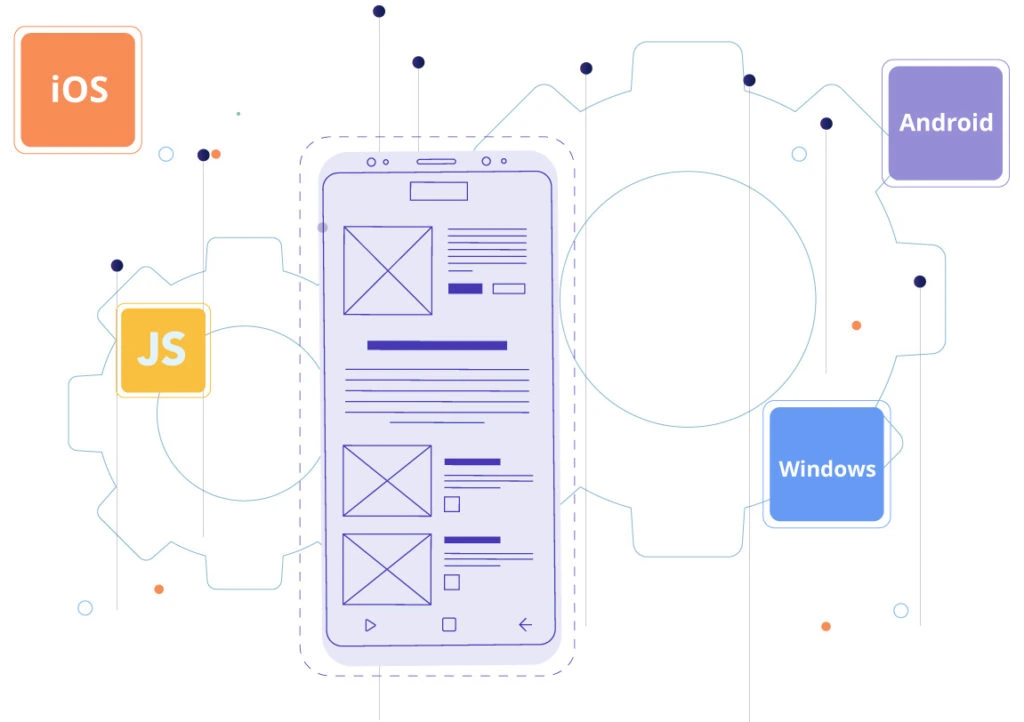Why React Native for Mobile App Development?

Creating cross-platform mobile apps traditionally requires developers to fight with their framework in order to create a seamless experience across iOS, Android, and Windows. The development of an intuitive user experience typically requires the use of the native mobile environment. However, developing on the native mobile environment comes with its own set of challenges including:
- Every change, no matter how small, requires the entire code to be recompiled
- Requires a diverse talent pool capable of developing across all platforms
- Extends the time-frame between running a test or experiment and receiving the results
- The QC/QA process takes far too long and when there is a bug figuring out its root cause can be burdensome
Despite these challenges, the benefits of having a truly intuitive app often outweighs the cost of overcoming these difficulties. This led to the development of a range of platforms that simplify the process of developing native apps. React Native, developed by Facebook, utilizes JavaScript to render native components allowing the same code to work across any native platform. This simplifies the code removing the burdens of developing a discrete app on each native platform while still delivering your users a flawless experience.
Reduce Your Development Costs with React Native
Normally you’d expect to utilize a new tool for creating native cross-platform apps to increase your costs of development. However, React Native simplifies the process of using native components bringing each platform into a single code. This means your developer team can continue to work within the languages they’re comfortable with, JavaScript. On top of this, Facebook releases a new version of React Native every two weeks ensuring your app is future-proof. They update for new native components, React components, overall usability, and more. These updates keep your app functional throughout updates of each native platform.
Utilize Existing React Components
One major way, by which React Native reduces development costs for cross-platform mobile apps is through the comprehensive library of React components. These components render elements in the virtual Document Object Model or DOM. They primarily consist of functional and class-based components. Functional components return a JSX, which describes the appearance of the UI. Class-based components use ES6 classes to hold values throughout the component that can be passed down through props.
For example, a simple “Hello” function using functional components looks like:
function Welcome(props) {
return <h1>Hello, {props.name}</h1>;
}This displays “Hello, [User’s name]” to the user. It fetches the user’s name based on the inputted props. The same function using class-based components looks like:
class Welcome extends React.Component {
render() {
return <h1>Hello, {this.props.name}</h1>;
}
}While the class-based component contains less concise code, it allows additional functionality. Class-based components can update while the page is open enabling a simple way to create an interactive app that responds to the user in real-time. A simple example of this would be adding a timer that displays how long the user has been logged in to the app. This would use a tick function that updates the UI at given intervals whether you want the user to know how long they have been logged in based on the second, minute, or hour.
By having an entire database of pre-built components, your development team can utilize these components to keep your code concise while saving your developers precious time. These components also work throughout native mobile environments and oftentimes work within desktop systems as well. Your developers can write the code once and release it on almost any platform with the same code base.
Develop Your Entire Project With One Development Team
Normally, cross-platform mobile app development requires a distinct team for each platform you wish to release your app on. With the growing number of mobile operating systems including iOS, Android, Windows, Chrome OS, WebOS, and much more, the task of creating a mobile app that works on any device is becoming extremely burdensome. Once you release the app on all platforms, you now have to worry about maintaining that app as these operating systems receive continuous updates. On top of this, these separate teams will require a skilled project manager overseeing each development team to ensure your app has continuity across all devices.
This is where React Native truly shines. Instead of having several development teams creating the same app with different codes, React Native simplifies this into a single code base. Now you can create an expert team utilizing a single language and ensure your app provides a consistent experience across platforms since they are all using the same code. This not only reduces the time required to release your app across platforms but also requires less expertise throughout your staff reducing your employee expenses.

We’re all familiar with the usual three costs of development; time, cost, and quality. Typically you cannot improve one without harming one of the others. However, using React Native breaks this rule. It allows you to quickly create cross-platform mobile apps that utilize native components at a lower cost and with higher quality than traditional development methods.
Debugging From a Single Code Base
React Native also helps streamline the development process so you can bring your app to market faster is through allowing debugging within a single code base. This speeds up the final stages of releasing your app while ensuring your app is appropriately debugged on every platform.
Additionally, React Native apps can use Chrome DevTools to debug the app. This allows your team the option of concurrent debugging. Your development team can debug the app during the development process. This allows you to roll out your app as soon as it is complete. Concurrent debugging significantly speeds up the development process and allows for more effective testing during the development process.
By debugging during development, you can be sure your development team is building the product you desired throughout each stage of the development process. Your QA team can also test the product during each stage without being encumbered by bugs within the app. Overall, concurrent debugging saves time on your QA process and debugging from a single codebase saves time for your development team.
Release Your App On All Platforms at Once
In most scenarios, the most significant cost savings from using React Native is not within the development phase at all, but rather in marketing. By releasing a consistent app across all platforms at once, you won’t need to set aside portions of your marketing budget to releases on different platforms. According to Fiksu, one of the leading mobile app marketing agencies, pushing an app into the top 25 ranks can cost upwards of $200,000 in advertising. Needless to say, this is a significant portion of the expenses to develop a mobile app.
Releasing your app on all platforms at once through React Native will reduce the redundancies of your marketing budget. You can market all platforms at once, allowing for a comprehensive marketing strategy instead of piece-mealing it together as the app releases on each platform. This not only lowers your overall marketing budget but also increases the referral rates as anyone can refer your app to others regardless of the device they have. Overall, you’ll have more effective marketing for your app at a lower cost.
Current Mobile Apps That Utilize React Native
Given the significant benefits and minimal downsides of developing cross-platform mobile apps with React Native, some of the top companies quickly began to utilize its capabilities. Unsurprisingly, Facebook put React Native to use in developing their mobile ads manager app. The framework allowed them to handle a wide variety of formats required for a successful ad campaign. It creates a seamless experience displaying interactive functionality like date formats, currencies, time zones, and more. All of these features are packed into one of the simplest ad managers out there with an intuitive UX and a simplified navigation menu based on what you use most.
Airbnb also decided to build its mobile app with React Native. They have a team of over 60 developers solely working on React technology. The React technology allows their users to quickly and easily create listings or browse listings with a sophisticated search and filter system. This also allows their desktop version to function in the same way as their mobile app so their users have a consistent product to work with.
Discord is a great example of React Native’s capabilities to create cross-platform apps with over 98% of their code being shared between iOS and Android. It also shows a great example of class-based components allowing their users to pull up their chat histories and view other user’s availability in a seamless interface.
All three of these cross-platform mobile apps heavily rely on a consistent experience for their users regardless of what operating system they use. But, the list does not stop there. Other notable apps developed with React Native include Instagram, UberEats, Gyroscope, Bloomberg, and Myntra. With updates every other week, the full capabilities of React Native are expanding with each update. While we cannot say where this technology will go, one thing is clear, it’s here to stay.
Whether you’re looking for advice on how best to utilize React Native to develop your new app or a full development team, Taazaa can help streamline the process of bringing your next app idea to market.
FAQ
What’s The Difference Between React and React Native?
React Native uses the React library to build native mobile applications instead of web applications, which is React’s primary purpose. The React Native framework allows you to utilize native components to create intuitive apps. It also requires you to write your styles in JavaScript instead of HTML and CSS. This means animations are created through React Native’s Animated API instead of CSS and simple stylings use the JavaScript language instead of CSS.
Does React Native Really Build Native Apps?
Yes, React Native really builds Native Apps. It uses JavaScript to execute the code rendering native components in Obj-C & Swift for iOS and Java for Android. This makes the end application indistinguishable from an application built in Obj-C & Swift or Java. The only difference being the way you describe the logic and interactions, which is in JavaScript instead of the native language.
Are There Any Advantages to Using React Native Instead of Flutter?
First, Flutter uses Dart instead of JavaScript. With JavaScript’s first release in 1995, there is already a huge knowledge base around the language making experts easier to find. Dart first released in 2011 making it a fairly new coding language even experts are still working to understand.
Additionally, React Native’s method of creating native applications are both common and recognizable within the coding community. This makes finding experts easier and simplifies the aspects of controlling the quality since proven best practices have already been established.
So, the main advantage of React Native over Flutter is its long-standing history making it easier to find experts, pull resources, and follow best practices.

